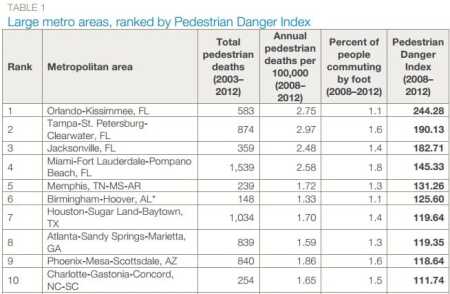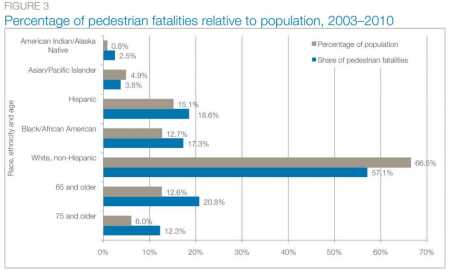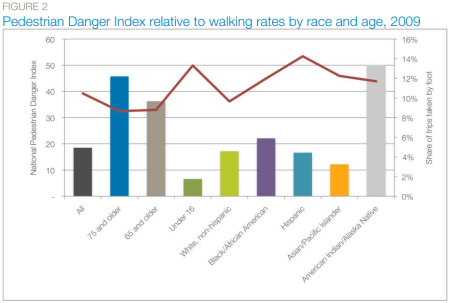A new report by Smart Growth America highlights the growing awareness of pedestrian safety issues. Dangerous by Design 2014 lists the most dangerous cities for walking, defines the most affected demographic groups, and provides recommendations as to what can be done to mitigate the growing problem.
According to the report, which was released by the organization’s National Complete Streets Coalition, Orlando-Kissimmee, Florida, claims the title as the metropolitan area that is most dangerous for pedestrians, with Tampa–St. Petersburg–Clearwater, Florida; Jacksonville, Florida; Miami; and Memphis, Tennessee, rounding out the top five. Sunbelt cities overwhelmingly dominate the list of most dangerous cities, claiming all of the top ten spots.
The report’s scoring metric, the Pedestrian Danger Index (PDI), is adjusted for pedestrian deaths relative to the number of people who walk to work in the region. Sunbelt cities rank as especially dangerous, as these metro areas “grewin the postwar period, mostly through rapid spread of low-density neighborhoods that rely on wider streets with higher speeds to connect homes, shops, and schools—roads that tend to be more dangerous for people walking.”
More traditionally dense, older cities scored highest for pedestrian safety, with Boston-Cambridge-Quincy, Massachusetts; Pittsburgh; Seattle-Tacoma-Bellevue, Washington; and New York–Northern New Jersey–Long Island, NY-NJ-PA, having the lowest PDI scores.
Nationally, 47,025 pedestrian deaths occurred between 2003 and 2012, with a further 676,000 injuries over the same period.
According to the report, the people most affected by pedestrian traffic deaths are older people and racial minorities. Older adults may have a reduced capacity to react quickly to traffic, and a lower likelihood of survival in a serious collision, which has put them at higher risk than people in other age groups. In addition, older adults “may have greater exposure to pedestrian crashes as they increasingly give up their car keys and seek alternative ways to get around,” putting them at a higher rate of risk than the younger population.
For minorities, the increased rate of pedestrian death is due to a greater percentage of trips being made by foot, as well as higher concentrations of minorities living “in urbanized areas, and in particular, suburban locations and along busy arterials routes, which are especially dangerous for pedestrians.”
The report makes recommendations on how to reduce pedestrian deaths. Improvements in street design are a key component to ensure that “the needs of all users—all ages, abilities, and modes of travel—are properly balanced, [making sure that] streets are safer and easier to navigate for everyone.” Corinne Kisner of the National Association of City Transportation Officials (NATCO) thinks that changes must be made in order to “counterbalance the legacy of street design that is heavily weighted toward rural and highway designs.”
Stephanie Seskin of Smart Growth America agrees, stressing the importance of the organization’s Complete Streets recommendations. She says, “Having a great Complete Streets policy with a comprehensive implementation plan, including specific steps to ensure Complete Streets vision are followed,” must be the first step toward reducing pedestrian deaths and injuries.



